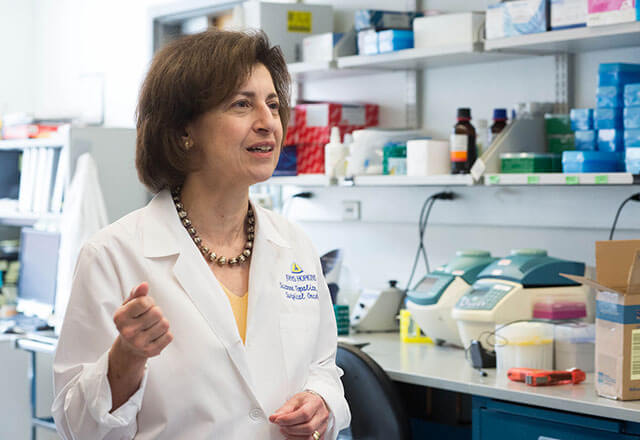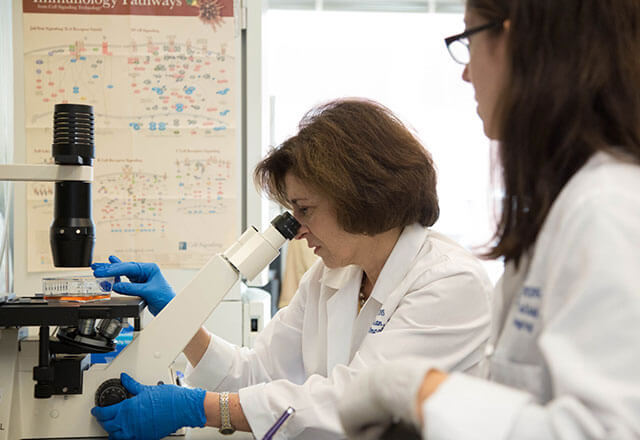Immune Modulation

The Immune Modulation Program, under the direction of Suzanne Topalian, M.D., is focused on understanding the natural immune response to cancer cells, and finding ways to change those immune cells to unleash their natural cancer-killing abilities.
Drug development to unleash an immune response
When the immune system recognizes cancer cells, two signals occur: The first is recognition — immune cells use certain receptors or “sensing molecules” on their surface to latch onto a tumor cell. The second signal is action — dozens of molecular pathways determine how the immune cell will respond to recognizing the tumor cell. It could respond with a stimulation event, where immune response is increased, or with a suppressive event, where the cancer-fighting ability is inhibited.
The Immune Modulation Program’s end goal is developing drugs that address either or both events, by enhancing stimulatory events to increase anti-tumor immunity in patients with cancer, or inhibiting suppressive events for the same net effect.
Suzanne Topalian Lab
Principal Investigator
Suzanne Topalian, M.D.
Our lab currently focuses on three areas of immunotherapy research: gaining a deeper knowledge of the biological underpinnings of human autoimmune response; discovering biomarkers that will help us identify which patients and tumor types are most likely to respond to various immune therapies; and developing immune-based treatment combinations that could deliver a more powerful anti-tumor response than monotherapies.

Drew Pardoll Lab
Principal Investigator
Drew Pardoll, M.D., Ph.D.
The Pardoll Lab focuses on the regulation of antigen-specific T cell responses and studies approaches to modify these responses for immunotherapy. Pardoll has a particular interest in cancer immunology and his lab’s studies on basic immunologic mechanisms have led to the development and design of a number of cancer vaccines and discovery of key checkpoint ligands and receptors, such as PD-L2, LAG-3 and neuritin, many of which are being targeted clinically.
Our primary pursuits are discovering and elucidating new molecules that regulate immune responses, investigating the biology of regulatory T cells, and better understanding the specific biochemical signatures that allow a patient’s T cells to selectively target cancer cells.

Junior Faculty Lab Members
Kellie Nicole Smith, Ph.D.
Fan Pan, M.D., Ph.D.
Immune Modulation Program
What is immune modulation?
Using drug therapy to change how the immune system responds to the presence of cancer cells.
What does it have to do with cancer?
Cancer cells have a way of evading detection by the immune system, which allows them to grow and spread.
What are the program goals?
Discover the checkpoints or stimulatory pathways that prevent the immune system from destroying cancer cells, then develop drugs that will modulate, or change, those pathways.
Develop new cancer vaccines to stimulate the immune system bringing more cancer-fighting cells to the tumor area.
What have researchers at Johns Hopkins learned so far?
There’s a pathway between molecules on immune and tumor cells that allows tumor cells to go undetected, but a new type of immunotherapy developed at Hopkins called anti-PD-1 can block this pathway in some cancers. We’re still studying it on difference cancer types, but so far, anti-PD-1 drugs are effective on melanoma, lung cancer and kidney cancer - to name a few.
Cancer vaccines aren’t having the same effect in advanced cancers, but lab research shows combining vaccines with other immune modulators like checkpoint blockades can have a powerful effect.
What's next?
- Design better vaccines
- Figure out the best way to combine vaccines and other immune modulating drugs
- Test whether cancer vaccines would be more effective against earlier stages of cancer
Determining why some patients don’t respond to immune modulators
One thing being studied under immune modulation is the coexistence of multiple types of signals in the same tumor and how that relates to patients’ ability to respond to a specific immune modulating therapy.
By taking biopsies before and after anti-PD-1 treatment, the team will be able to study the tumor microenvironment to find reasons for a response or lack of response. They’ve already discovered that in non-responding tumors there are multiple immune suppressive pathways being expressed at the same time in the same location. This knowledge is helping researchers come up with possible combination therapies, as well as checkpoint blockades that target other pathways, not just PD-1.

